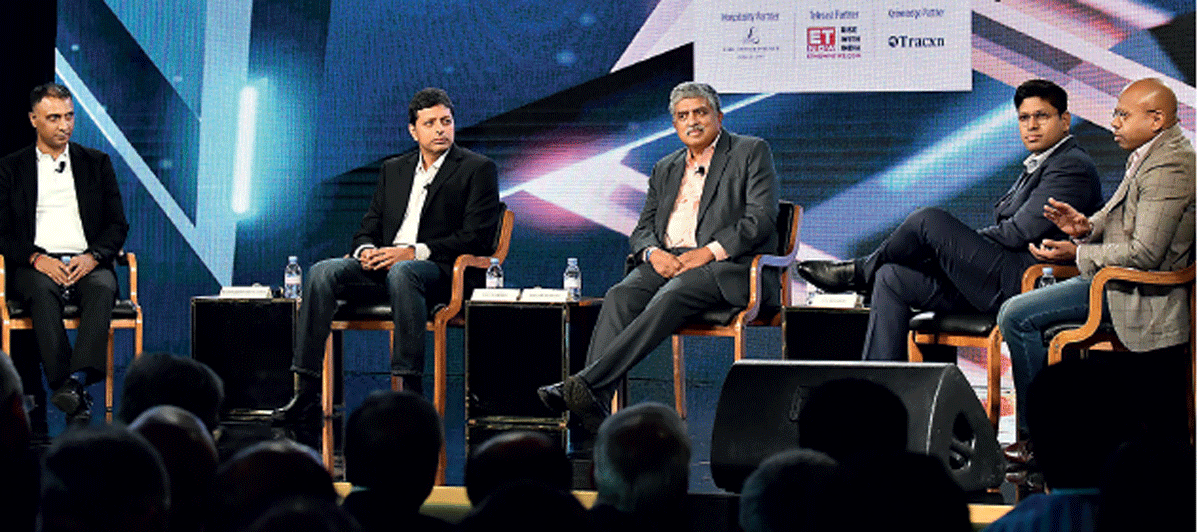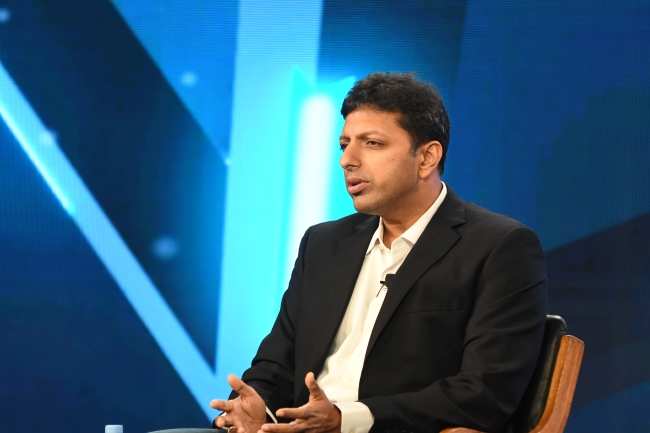 Building for ‘Bharat,’ or the next 500 million internet users, promises to be the biggest, yet the most challenging opportunity over the next decade for India’s consumer tech giants. This was the key takeaway from a panel discussion ‘The next frontier: Building digital businesses for Bharat’ at The Economic Times Startup Awards 2019 on Friday in which top technopreneurs, including Nandan Nilekani, cofounder & non-executive chairman of Infosys, Kalyan Krishnamurthy, group CEO of Flipkart, Amit Agarwal, global senior vice-president & country head of Amazon India, Aditya Ghosh, chief executive officer of Oyo India & South Asia, and, Peyush Bansal, the founder & CEO of Lenskart, participated. Edited excerpts:
Building for ‘Bharat,’ or the next 500 million internet users, promises to be the biggest, yet the most challenging opportunity over the next decade for India’s consumer tech giants. This was the key takeaway from a panel discussion ‘The next frontier: Building digital businesses for Bharat’ at The Economic Times Startup Awards 2019 on Friday in which top technopreneurs, including Nandan Nilekani, cofounder & non-executive chairman of Infosys, Kalyan Krishnamurthy, group CEO of Flipkart, Amit Agarwal, global senior vice-president & country head of Amazon India, Aditya Ghosh, chief executive officer of Oyo India & South Asia, and, Peyush Bansal, the founder & CEO of Lenskart, participated. Edited excerpts:ET: Nandan, how are businesses benefitting from Aadhaar, UPI, e-KYC? Do you see it impacting tier-2 and 3 cities?
Nilekani: I think, all the infrastructure that has been put in place in the last decade, the idea is to reach a billion people. Aadhaar is a very important instrument of inclusion, but there is also the e-KYC, which allows you to open bank accounts, get a mobile connection, I think, in two minutes. DBT (Direct Benefit Transfer) has also been a big part. These instruments are bringing everybody into the system. However, I think there are many different markets.
For example, when we tried to visualise how to make payments reach a billion people, we divided it into three markets – those with smartphones, which may be 300-350 million people; those with feature phones, about 300 million people, and the rest, who do not have any. We wanted to also provide UPI (Unified Payments Interface) in a feature phone, to enable them to make payments. People without phones had the Aadhaarenabled Payment System. Interestingly, the second option never took off.
ET: Given that the Indian consumer behaviour is different, how are you adapting to what people call India-2 or Bharat?
Krishnamurthy: Around 65%-70% of our customer transactions come from tier-2 and 3 cities. At Flipkart, solving for Bharat is not a strategy, it is the business. We have initiatives to solve for the top-6 or top-8 cities, but 18% to 19% of the company’s resources - financial and technology - are already going towards solving for Bharat. The consumer e-commerce market is roughly $23 billion in value. I think the only person who can disagree with that is Amit (Agarwal).
ET: Amit, what are your numbers? You aren’t very fond of projections?
Agarwal: You know me very well.
Krishnamurthy: If you think it’s less, it means we are gaining market share. So, sitting next to Amit on the same stage, I thought I will use the opportunity.
 ET: What’s your take, Amit? Are you losing market share?
ET: What’s your take, Amit? Are you losing market share?Agarwal: As you know, we are not really obsessed about competition.
ET: How do you make sellers also follow you deeper into markets?
Agarwal: I think a really transformational thing today is that everybody has mobile internet. If you think about Bharat as a supplier, manufacturer and seller, you have millions now empowered to reach out to consumers globally. Our Amazon Tatkal programme was essentially a van that used to go to all the remote parts of the country, trying to sign up sellers online. We are also excited about our aggregator programme, where we get artisans and women entrepreneurs on Amazon. These transformations make sense if it really changes people’s lives, otherwise it is just a transaction.
 ET: Oyo has become more of a real estate player, and at scale. What’s the reason?
ET: Oyo has become more of a real estate player, and at scale. What’s the reason?Ghosh: Oyo is a full-stack hotel company. Nandan was asking me, ‘what is the difference between you and Hilton?’ and I said, ‘we are just a little bit larger’.
ET: But, you were not always that big?
Ghosh: We had to decide we needed to be in control of what customers experience, and then build a business surrounding it. In November-December last year, we were in 280 cities in India. Now, we are in almost 600 cities. That means, we went in, found the hotels, transformed those properties, brought them up to standard.
ET: How has physical presence helped you target an audience, which a lot of digital businesses have not been able to do?
Bansal: We started with a very clear vision, to give vision to India, because there are 600-700 million people who need spectacles and only 170 million have them. During the journey, asking ‘how do we give to even half of those 600 million’ we realised the only way to do that was to be omni-channel.
ET: Policy changes have affected ecommerce. What do you expect on policy front?
Agarwal: One basic foundational block of that policy should be to embrace ecommerce as a key driver of the future economy. Then you, kind of work backwards and ask yourself ‘what are the friction points that could allow it grow faster?’ If entrepreneurs want to do business in more than one state, they have to deal with more forms and taxation regimes. So, I think very simple changes can actually have a multiplier effect on what they do online and what they can actually do.
 ET: What do you want the government to address on policy that will help businesses?
ET: What do you want the government to address on policy that will help businesses?Krishnamurthy: Digital payments have been one of the biggest challenges in the past. A big part of the business continues to be cash driven, and (is) moving to digital payments. I would request the government to think of spending a lot more on technology R&D.
ET: Your expectations on speeding up adoption of internet as well as inclusion?
Ghosh: R&D has remained reasonably flat for 20 years now. It is less than 1% of our GDP. We have nearly 130 million new voters and assuming these 18-23 year-olds are building their lives, businesses, livelihoods and families for the next 20 years, what are the enabling factors that can create more opportunities for this demographic? Is it science and math education, spend on R&D or just pure tele-density and internet-density, which is a big divide between urban and rural areas? Has the gap shortened? Of course! But, it is still one-third or one-fourth of that in urban areas. Omni-channel will help us get there, but can this get us there faster, is the question.
ET: Privacy is also a big factor, especially for new users. How do you enable digital literacy for this new set?
Nilekani: A lot of responsibility lies with the company. Mr (Ravi Shankar) Prasad (Union IT Minister) has been key in laying the framework for what companies can or cannot do. I think the bigger issue is fraud, phishing, where you have new users come online and people taking advantage of their naivete to get something. Both the government and companies need to do something about it.
ET: Do you think the competitive landscape is going to be different going forward given that Reliance Jio, which was a big facilitator, is now also in the fray?
Agarwal: The beauty of the internet is that it’s completely transparent and customers can choose a truly superior experience. We assist customers every day, so that they choose us only because we provide a superior experience which will be the only tiebreaker that matters.
ET: Any closing remarks...
Ghosh: Can technology solve the hard problem that makes a difference in people’s lives? I am obsessed about that. If it is about solving a hard problem, then everything else will follow.
Bansal: Bharat, and people at all income levels, demand great experience. To them, Rs 500 means a lot more than what Rs 5,000 means to us. It is very important to understand that, as we build businesses for Bharat.
Nilekani: I think Bharat is about high-volume, low-cost video, voice, local language, full stack, consistent experience.
Agarwal: I think what is good for customers is actually accelerating a digital Bharat, and transforming lives. Krishnamurthy:While Bharat is the most exciting and the biggest opportunity in the next five to 10 years, it is also the most challenging. The penetration of ecommerce and retail is negligible today, so it is a massive opportunity.
No comments:
Post a Comment